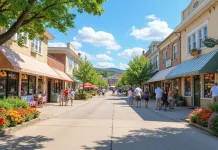Historic Ghost Towns to Visit in the United States
Exploring Abandoned Echoes of the American Past
Visiting ghost towns in the United States is like stepping into a time machine, offering a unique glimpse into the country’s vibrant past. These abandoned settlements, once bustling with life due to gold rushes, mining booms, or railroads, now stand as silent monuments to history. They allow us to peek into bygone eras and imagine the stories that walls and streets could tell. Here’s a tour through some of the most intriguing historic ghost towns you can visit in the U.S.
Bodie, California
The Crown Jewel of California’s Ghost Towns
Bodie is one of the most famous ghost towns in America, renowned for its authentic preservation and fascinating past. Nestled in the eastern Sierra Nevada mountains near the California-Nevada border, Bodie was once a thriving gold mining town.
History and Decay
Founded in 1859, Bodie boomed after the discovery of gold in 1876. At its peak, the town boasted around 10,000 residents, complete with banks, saloons, a jail, and a red-light district. However, as the gold veins were exhausted and mining companies moved on, Bodie’s population dwindled. By the 1940s, it was a ghost town.
What to See
Preserved in a state of “arrested decay,” Bodie looks much like it did when its last residents left. Original furniture, belongings, and structures remain largely untouched. On a walk through Bodie State Historic Park, you can visit the Methodist Church, the Bodie Schoolhouse, and numerous dilapidated homes and businesses. Don’t miss the Bodie Museum for a deeper dive into the town’s colorful past.
Custer, Idaho
A Forgotten Jewel of the Gem State
Custer, Idaho, located in the rugged terrain of the Yankee Fork Valley, was once a bustling mining community. Today, it offers a quiet glimpse into the past, nestled in the stunning scenery of central Idaho.
Historical Background
Founded in 1879, Custer quickly grew due to nearby gold and silver discoveries. However, like many mining towns, its fortunes were tied to the precious metals, and it was abandoned by the 1910s when the resources ran out.
Attractions in Custer
Custer is now part of the Land of the Yankee Fork State Park and has been partially restored to give visitors insight into its history. You can explore several restored buildings, including the Empire Saloon, schoolhouse, and blacksmith shop. The Custer Museum provides artifacts and photographs chronicling the town’s vibrant past. While you’re there, enjoy the breathtaking mountain scenery and perhaps go fishing or hiking in the nearby area.
Rhyolite, Nevada
The Ghost of the Bullfrog Mining District
Located on the edge of Death Valley, Rhyolite is one of Nevada’s many ghost towns but stands out due to its unique ruins and quick rise and fall.
The Rise and Fall of Rhyolite
Rhyolite was established in 1904 during a gold mining boom and rapidly developed into one of Nevada’s largest cities, housing an estimated 5,000 to 10,000 people. However, by the 1910s, the financial panic and the subsequent gold depletion led to its decline.
Exploring Rhyolite
The town offers a fascinating sight with its partially collapsed Headframe and the remarkably still-standing Bottle House, made of 50,000 beer and liquor bottles. The remnants of the three-story Cook Bank building, built in 1908, stand as a testament to the grand dreams of its founders. Make sure to visit the nearby Goldwell Open Air Museum, an outdoor sculpture park adding a touch of modern artistry to the historic ruins.
St. Elmo, Colorado
Living History in a Victorian Mining Town
Nestled in the heart of the Colorado Rockies, St. Elmo is one of the most picturesque ghost towns in the United States. It offers a palpable sense of its past splendor, wrapped in the stunning beauty of the surrounding mountains.
St. Elmo’s Story
St. Elmo was founded in 1880, its growth fueled by significant gold and silver finds. The town thrived with a population of over 2,000 residents and the accompanying amenities of a successful mining community. However, after the closure of the area’s mines post-World War I, St. Elmo’s population dwindled, leaving it largely abandoned.
What You Can See and Do
Today, St. Elmo remains one of Colorado’s best-preserved ghost towns. You can still stroll along its main street, lined with well-maintained buildings such as the old schoolhouse, the St. Elmo General Store, and the Miner’s Exchange Saloon. The town is open for exploration throughout the year, inviting visitors who can also enjoy hiking, fishing, and off-roading in the surrounding terrain.
Virginia City, Montana
An Epitome of Gold Rush Glitz and Glory
Virginia City offers one of the most immersive experiences into the United States’ gold rush era. As a designated National Historic Landmark, this Montana ghost town operates almost like a living museum, thanks to its storied past and preservation efforts.
The Rich History of Virginia City
Founded in 1863 after the discovery of gold at Alder Gulch, Virginia City became the territorial capital of Montana. For a time, it was a bustling hub filled with miners, merchants, and merry-makers. But as with most mining towns, as the veins of precious metals ran dry, so did its population.
Delving into History
Today, visitors can explore a plethora of restored buildings, including opera houses, old-time saloons, and general stores filled with vintage goods. Be sure to catch a show at the Virginia City Players theater for an authentic experience. You can take a historic stagecoach ride and visit the Nevada City Museum just down the road, which offers more insights into the area’s Gold Rush heritage.
Thurmond, West Virginia
A Relic of the Coal Mining Empire
Set against the lush greenery of the New River Gorge, Thurmond was once a prosperous center for the transport of coal. Now, it stands as a ghost town, where the echoes of steam engines once reverberated through the valley.
The Heyday of Thurmond
Established in the late 19th century, Thurmond thrived as a rail town supporting the colossal coal industry. It was famously known for hosting more freight than Cincinnati and Richmond at one point. But as diesel trains replaced steam and industries evolved, the town fell into decline.
What Awaits You in Thurmond
Visitors to Thurmond can tour the old depot, which is now part of the New River Gorge National Park and Preserve, to learn about the area’s rich past. The remaining structures, including the coaling tower and rail yards, offer a poignant reminder of its bustling history. Strolling through this quiet ghost town, you can almost hear the whispers of its once-vibrant life.
Cahawba, Alabama
Alabama’s First State Capital and Its Enigmatic Remains
Once Alabama’s state capital, Cahawba is now an intriguing ghost town ripe for exploration. Set at the confluence of the Cahaba and Alabama Rivers, the town’s rich history and eventual abandonment tell a unique tale of the state's early years.
The Rise and Fall of Cahawba
Cahawba served as Alabama's first capital from 1820 to 1825. Over time, flooding, a move to relocate the capital, and the decline of the region’s agricultural economy led to its abandonment by the early 20th century.
Visiting Cahawba
Today, Old Cahawba Archaeological Park preserves the remnants of this historic town. You can explore walking trails that lead past old streets, brick foundations, and the intriguing ruins of what once was a thriving city. Make sure to visit the cemetery and old church site, which add to the hauntingly beautiful aura of this place.
Kennecott, Alaska
The Remote Copper Mining Wonder
Set amidst the stunning vistas of Alaska’s Wrangell-St. Elias National Park, Kennecott stands as a testimony to the power of the copper mining industry in the early 20th century.
The Wealth Below the Ice
Founded in 1903, Kennecott quickly became a hub due to the area’s high-grade copper ore. Over the following decades, the town thrived with a hospital, skating rink, and pool hall, until the mines were depleted and it was abandoned in 1938.
Discover Kennecott
Now a National Historic Landmark, Kennecott offers a glimpse into the grand industrial past with its well-preserved buildings, including the striking 14-story concentration mill. Guided tours are available to share the captivating stories of the town's heyday. Visitors can hike the pristine trails around the park, offering opportunities to spot wildlife and enjoy the breathtaking Alaskan landscape.
Mogollon, New Mexico
An Enchanting Glimpse into New Mexico’s Mining History
Tucked away in the Gila National Forest, Mogollon was a formidable mining town during its peak, reflecting the adventures and hardships of those seeking fortune in the rugged lands of New Mexico.
A Swashbuckling Past
Founded in the 1870s, Mogollon attracted hopeful miners after discoveries of gold and silver. The town had numerous saloons, stores, and even its own band. But by the 1940s, decreased ore quality and a fire had reduced the town to just a few residents.
Exploring Mogollon’s Charm
Today, Mogollon offers a unique ghost town experience with its preserved structures, including the old Silver Creek Inn and various cabins. The Mogollon Museum and old theatre offer a deep dive into the local lore and history. The scenic drive into the town, winding through mountainous terrain, is an adventure in itself, promising stunning vistas and wildlife sightings.
Alderson, Oklahoma
Echoes of the Coal Era
Alderson, though not as famous as other ghost towns, offers a different look at early American life, showcasing the stories from the coal industry rather than the more glamorous gold rush tales.
The Boom Before the Bust
Once thriving due to its coal deposits, Alderson was home to miners and their families. However, as coal demand shifted and mines closed, the town saw its population decline through the mid-20th century.
Visit Alderson
What remains of Alderson provides visitors with a glimpse into the lives of coal miners. You can see old houses, the remnants of infrastructure, and the cemetery where miners laid to rest their loved ones. It’s not far from McAlester, offering an easy diversion for those interested in Oklahoma’s lesser-known historical sites.
South Pass City, Wyoming
A Snapshot of Frontier Life
Nestled in the hills of Wyoming, South Pass City offers a vivid glimpse into the life and times of a frontier mining town. This small settlement played a key role in the westward expansion of the United States.
From Boom to Historic Landmark
South Pass City sprang to life in the 1860s with the discovery of gold. For a short while, it was a bustling hub, complete with saloons, hotels, and breweries. However, when gold supplies dwindled, the population followed suit. By the late 19th century, it was largely deserted.
Step Back in Time
Today, South Pass City is one of Wyoming’s best-preserved historic sites. Visitors can tour over 30 original structures, including a general store, post office, and the Carissa Mine. There’s also an informative visitor center that provides an overview of the town’s history and significance in the region’s development.
Glenrio, Texas/New Mexico
Route 66’s Enduring Tale
Spanning the border of Texas and New Mexico, Glenrio is a quintessential American ghost town that tells the story of life along the famous Route 66.
Crossing the Frontier
Initially founded in the early 1900s as a railroad town, Glenrio quickly became a stop for travelers along Route 66. However, the construction of Interstate 40 bypassed the town, leading to its decline.
The Echoes Along the Mother Road
Today, visitors to Glenrio can see the remnants of this once-busy stopover, including an old motel, a gas station, and business facades from its peak era. While it sits quietly, the town remains a symbol of the romantic spirit of road travel. A visit to Glenrio offers a nostalgic look back at the golden age of the American road trip.
Shaniko, Oregon
The Wool Capital That Stood Still
Situated in north-central Oregon, Shaniko serves as a fascinating relic from the days when wool was the “gold” driving the local economy.
A Boomtown for Wool
Once known as the “Wool Capital of the World” in the early 20th century, Shaniko thrived on its wool, wheat, and sheep industry. However, as railway routes changed, the once-bustling depot town saw its prosperity decline.
Exploring Shaniko
Despite its faded glory, Shaniko invites visitors to explore its past with preserved structures and historic reenactments during tourist season. Key sights include the Shaniko Hotel and the Sage Museum, which provide insights into the frontier life that shaped this unique community.
Calico, California
A Silver Mining Hub Turned Attraction
Calico stands out as a vibrant ghost town, drawing visitors to experience the lifestyle of a silver mining boomtown while enjoying the Mojave Desert’s unique landscape.
A Boomtown Reborn
Found in 1881, Calico was a hub of silver mining. By the mid-1890s, however, the mines played out, and the town was abandoned. In mid-20th century, Walter Knott, of Knott’s Berry Farm fame, purchased and restored the town, turning it into a lively tourist attraction.
Calico Today
Now a San Bernardino County regional park, Calico gives visitors a chance to explore recreated and original buildings, participate in gold panning, and enjoy mine tours. The annual Ghost Town Haunt during Halloween is a particular favorite, offering a spooky and fun way to experience the town’s eerie past.
Jerome, Arizona
From Ghost Town to Thriving Artists’ Colony
Perched high on Cleopatra Hill in Arizona, Jerome was once a bustling mining town, known for its rich copper deposits, vibrant community, and, eventually, its descent into ghost-town status.
The Rich Veins of Copper
Founded in the late 19th century, Jerome quickly blossomed due to its mining industry. However, as the economy shifted and resources were exhausted by the mid-20th century, Jerome’s population plummeted.
A New Chapter for Jerome
In recent decades, Jerome has experienced a renaissance as a vibrant artists’ community. Visitors can explore historic sites like the Mine Museum and old Jerome State Historic Park. The town’s narrow streets, lined with charming shops and galleries, provide a delightful daytime exploration, making Jerome a unique blend of ghost town charm and modern artistic flair.






























